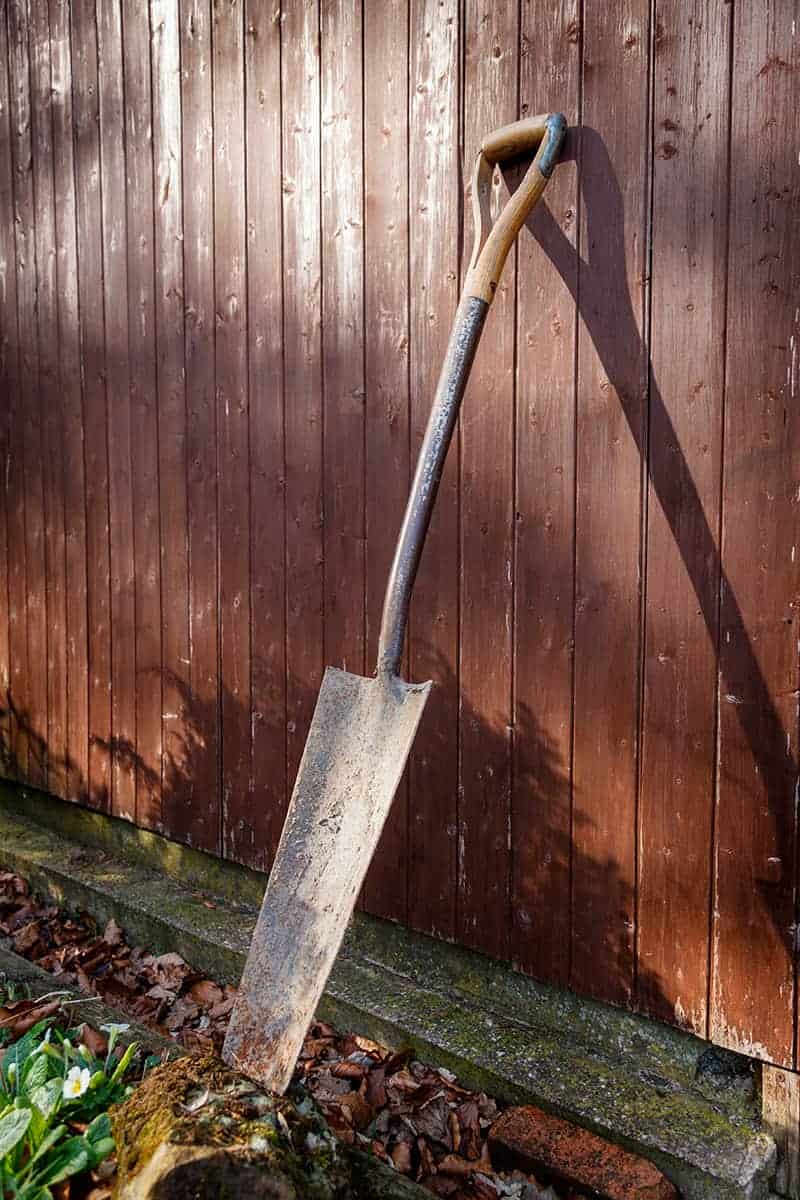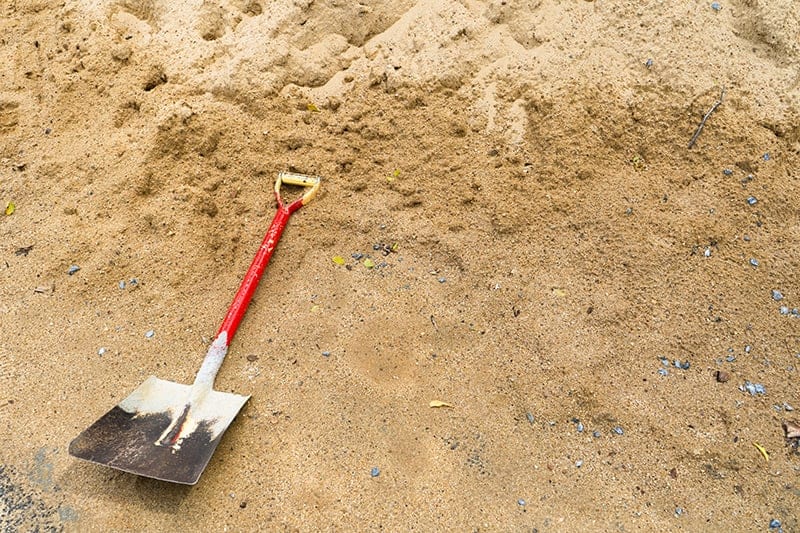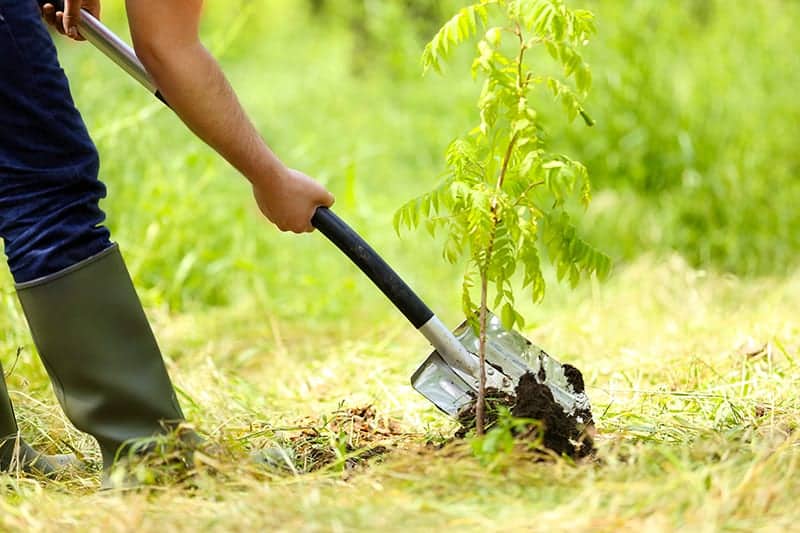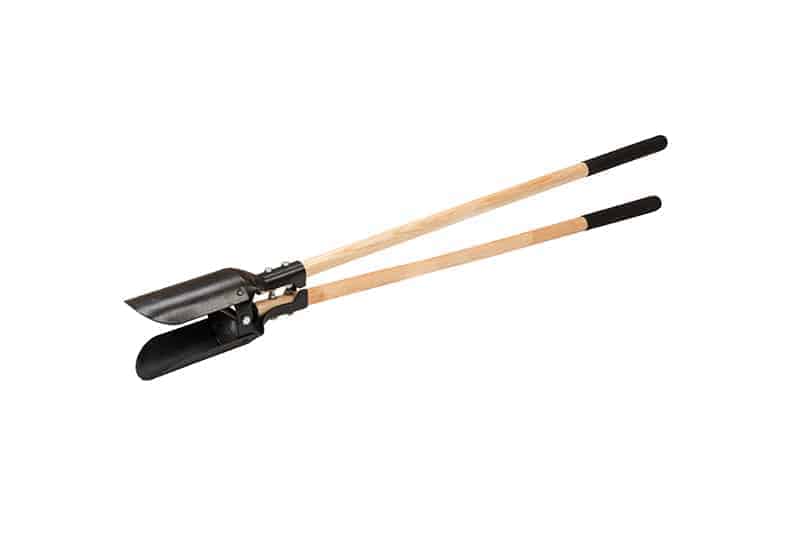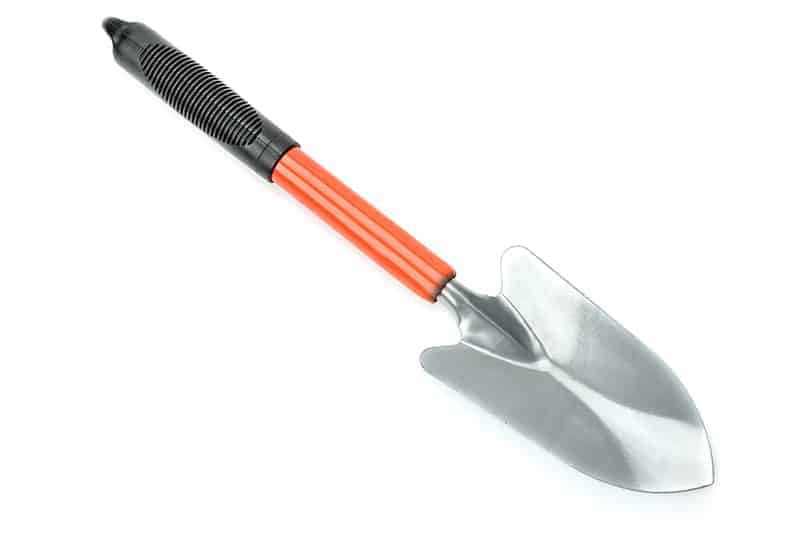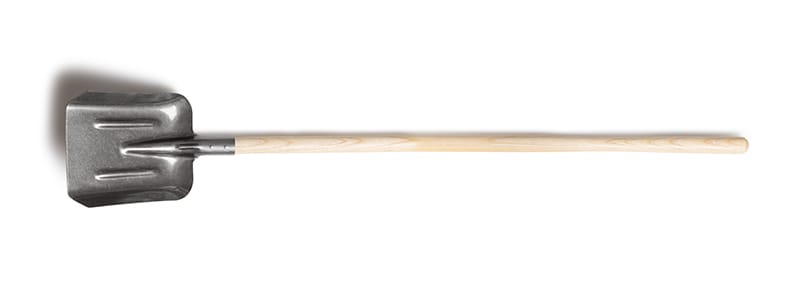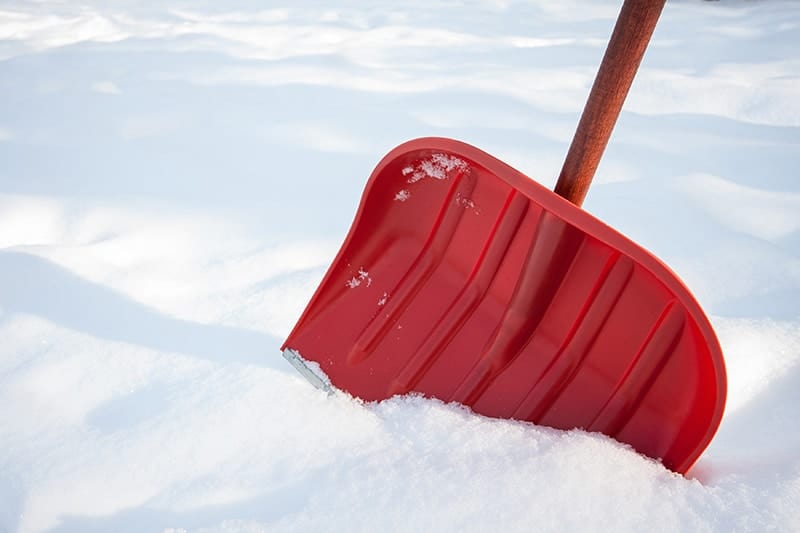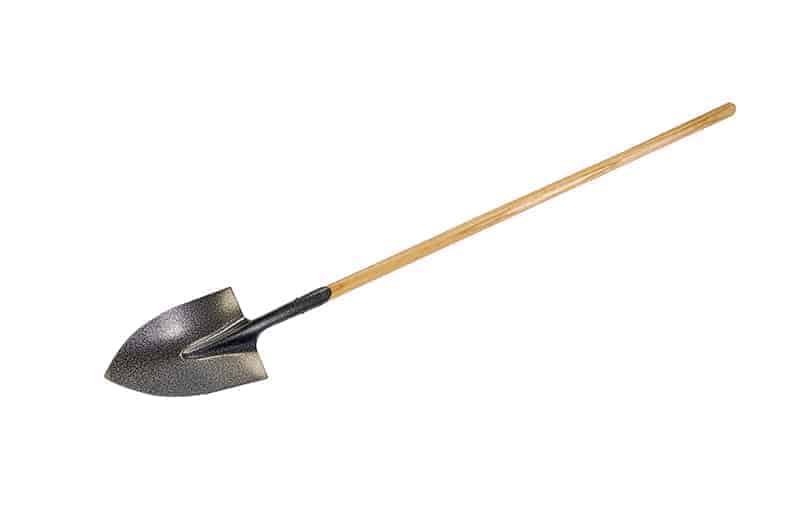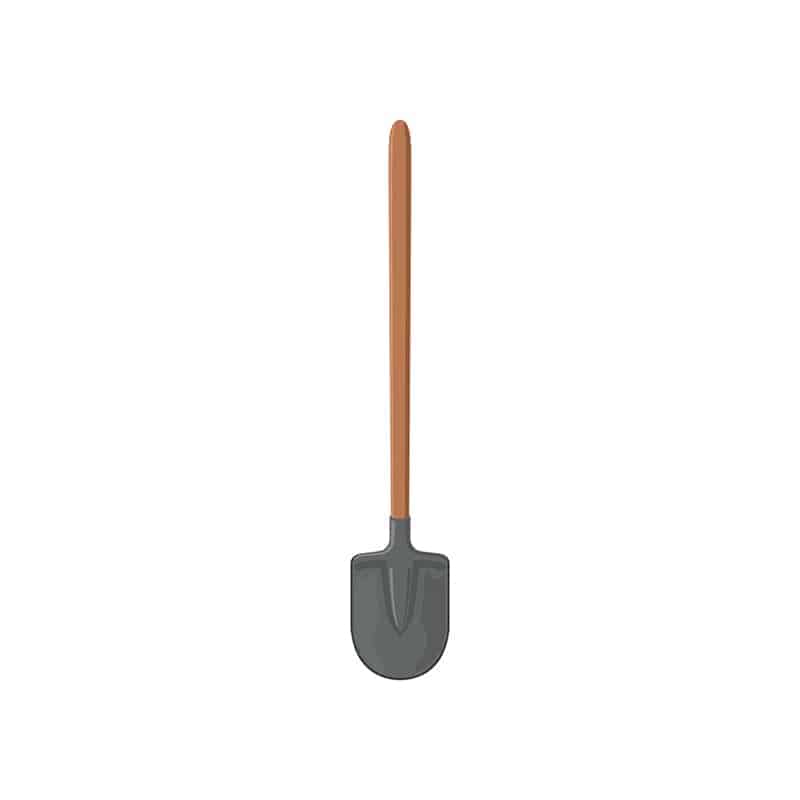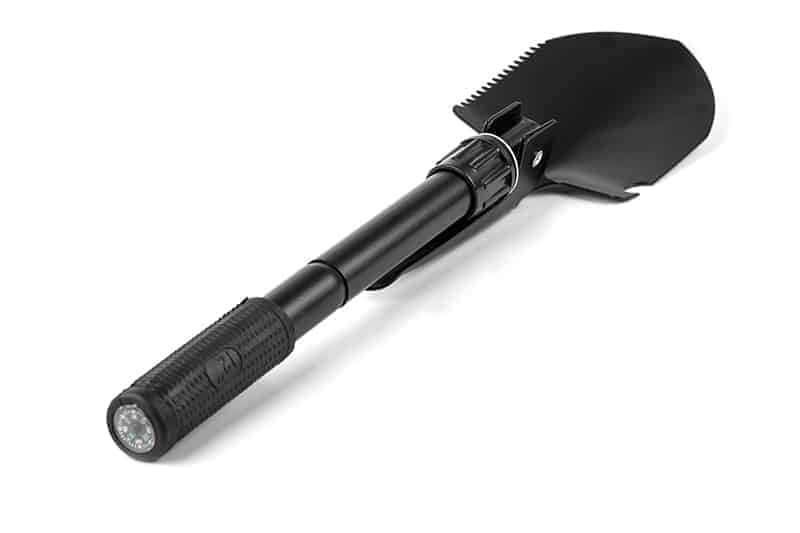One of the most disappointing things as a gardener is to spend all spring ... Read More
- Home >
- 11 Different Types of Shovels (Anatomy, Uses & Pictures)
11 Different Types of Shovels (Anatomy, Uses & Pictures)
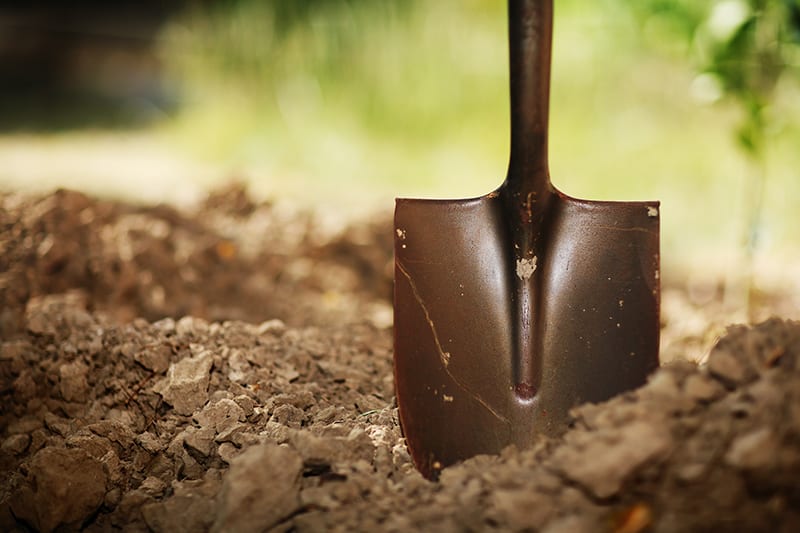
There are so many different types of shovels, and choosing the right one for the job can make the difference between a long day of hard labor or a simple and easy task. Shovels are invaluable garden tools, some of which are specifically designed for one job, and some of which are great workhorses that can be used for a whole host of garden activities. To fully understand the different types of shovels, first, it’s a good idea to learn about the anatomy of a shovel.
Here, we offer simple explanations for the different parts of a shovel, then we’ll into details about 12 types of shovels.
Parts of a Shovel
A. Grip
The grip of a shovel is the uppermost part, which is attached to the shaft. It can take the form of a wooden, plastic, or metal handle, but often there may be no handle at all, and you can use the shovel by holding onto the top part of the shaft. If the shovel shaft is made from fiberglass, then a grip handle will be attached to help prevent splinters. A D-shaped handle is common amongst shorter shovels and digging shovels, which help to increase grip.
B. Shaft
The shaft of a shovel is the long ‘pole’ like part of these tools, and it is used as leverage when operating your shovel. They are usually made from wood, fiberglass, or metal. All of these materials have pros and cons in terms of shovel use and durability, and the type you want to choose may come down to personal preference or budget. Metal shafts tend to be the strongest and most long-lasting, but wooden shafts are usually more ergonomically and aesthetically pleasing and are more popular with traditionalists. The length of a shovel shaft can vary, and the height of your shovel should be matched to your own height so that it is comfortable to use.
C. Collar
The collar of a shovel is where the blade meets the shaft. It’s important that the collar is secure and sturdy; otherwise, it may crumble or snap during heavy work. The collar usually connects to the shaft and handle portion of the shovel with a rivet or screw, and can be disconnected if you need to replace either end. A blade usually has a much longer lifespan than the shaft and handle, so if either of those parts breaks, then you can buy replacements and attach them to your old blade at the collar.
D. Kickplate
The kickplate of a shovel is also known as a step. It is the uppermost edge of a blade where you can place your foot to add pressure, though not all shovels will have a kickplate. Kickplates are usually found on digging shovels where the extra weight of the user can be utilized to dig deeper into the ground. Using a kickplate will achieve better results, and also makes the job much easier for the user, as they can use their weight to help dig rather than just arm and back muscles.
E. Blade
The blade of a shovel is the lowermost part of the tool, which makes contact with the ground. It is usually made of metal or aluminum, though in some instances might be fiberglass or plastic. Shovel blades come in a wide range of shapes and sizes, and it is arguably the design of the blade that makes the most difference between different shovel types.
F. Tip
The tip of a shovel is the lower edge of the blade, furthest from the shaft. It takes various shapes depending on the intended use of the shovel. Flat tips are best for scooping or moving, while pointed and rounded tips work best for cutting and digging.
Buying Guide
If you’re looking for a new shovel, take a minute to think about these considerations before making your choice. Purchasing the right tool for the job will make life much easier and save you time and money.
A. Intended Use
There are numerous shovels available which have been designed with specific needs in mind. If you’re an avid landscape gardener and enjoy having plenty of tools to get the job done just right, then go ahead and buy the shovel designed exactly for the job at hand, e.g., a trenching shovel for digging trenches, or a post hole shovel for creating post holes. However, if you’re fairly inexperienced in gardening and won’t be spending too much time working in your hard, then you’ll be better off buying just one good quality digging shovel. If you buy right, a digging shovel will last you many years, maybe even decades, and can be used for a multitude of garden jobs, including trenching, weeding, digging, and moving soil.
B. Blade Shape
The shape of the blade you want for your shovel will depend on the type of soil you have, so make sure you know what you’re working with before you make a purchase. Flat edged shovels are best for working with loose soils, and they are also good for scooping and edging. Round blades are better suited to softer or newer soils, while pointed shovels are best in hard or compacted soils.
C. Size and Weight
The height of the shovel is important to prevent physical pain of the user, most commonly upper back or shoulder pain. The ideal height of a shovel should be about four inches lower than your shoulder when it is stood up straight. The weight is also an important consideration, as a heavy shovel will tire you out quickly, whereas a light shovel will not be as durable. This is why some people own various shovels for different jobs, so they can customize the type of shovel they’re using to the type of task they want to complete. If you plan to use your shovel to move lots of material, for example, a large pile of stone pebbles, then a lightweight shovel will be better so that you can move the pebbles without getting exhausted. For digging, a heavier shovel will be best, as these will be sturdier and more able to handle the pressure that comes with digging ground.
D. Construction Material
The construction material of a shovel is a vital consideration when choosing which shovel to buy, and the material you want will depend on your requirements. For heavy-duty jobs, you will need a heavy-duty shovel, so one made from solid steel will be best. If the whole shovel is made from one solid material, then it won’t snap at the collar point (as this is the weakest point of most shovels and the cause for most breakages). If your shovel will be used for lighter work, such as scooping and moving soil, then aluminum may be a good choice as it weighs less but is relatively sturdy.
Many premium shovels are now made from titanium, which has the benefit of being lightweight but also exceptionally sturdy, even more so than steel. Titanium is also resistant to rust and will not corrode, resulting in a long-lasting shovel. Titanium shovels do come with a big price tag, which might be off-putting to many people, but if you’re looking for a reliable shovel that will be with you through the years, then a titanium shovel is an excellent choice. Also pay attention to the material of the collar on a shovel, and the way that the handle and blade are attached to the shaft. A bolt will prove to be the most long-lasting, while a screw joint or press-in connections will generally not last much beyond a year.
Types of Shovel
1. Edging Shovel
This shovel is specifically designed to create neat edges around lawns or borders, creating a clean definitive edge. It has a long shaft, with a small-sized metal semi-circle attached at the bottom, and a straight footplate where you can apply pressure with your feet. The blade is usually sharp and flat, as it should be pressed directly straight down into the lawn or soil. The blade is quite shallow, as it does not need to make deep cuts to be effective. While these are predominantly used for their main purpose of creating and maintaining garden edging, they can also be useful for other tasks, including breaking up shallow roots of plants. As these shovels have quite a small blade, they are ideal for use in small areas where you need to be quite specific to avoid harming nearby plants.
2. Trench Shovel
Also known as a ditch shovel, the trenching shovel has two primary uses. Firstly, it can dig shallow trenches, and secondly, it can clean out and neaten up deeper trenches that have been created by a more powerful tool. Trench shovels have a long and narrow blade with a pointed tip, and the blade is set at an angle. Due to how narrow the blade is, there is hardly any footplate space, so driving the shovel into the ground with your weight isn’t really an option, and instead, you’ll have to use arm power. This means that anything more than a shallow trench would become very difficult and tiresome to achieve. Trench shovels are predominantly used by landscape gardeners.
3. Flat Shovel
As the name tells us, flat shovels have a flat blade. Any shovel with a flat blade is primarily designed for scooping, and they often have a slightly concave blade, like a squared-off spoon, that makes them better at carrying materials. They are useful for moving garden materials around, such as soil, mulch, or gravel, and are ideal for loading wheelbarrows or other garden containers. The flat blade means they are not great at digging, but they have a large footplate that will help you add pressure to force the blade into the ground. This is useful for shallow digging tasks such as edging or cleaning our trenches. If you want to use it for this purpose, it will work best with soft soils. Primarily, a flat shovel is for scooping, spreading, and moving, but it’s a very useful garden tool to have around as it can work for other functions.
4. Tree-Planting Shovel
These shovels are specifically designed for planting trees, making quick work of a job that would take much longer with other types of shovels. A tree-planting shovel has a narrow blade that comes to either a curved or pointed tip. The narrow blade means it can dig various sized holes, by working the shovel into the ground in a circular shape. The shaft can vary in size depending on what you need for your task, with longer shafts being better for flat and even ground and shorter shafts working better on hills or sloped ground. These shovels can be used to dig up a tree for transplanting, or creating a new hole to plant a tree. The shovels are a similar shape to a trenching shovel, and so can double up to create shallow trenches where a long trench for a flower bed makes more sense than creating lots of small plant holes. It can also be used to clean out pebbles or debris from bigger trenches.
5. Power Shovel
There are two different tools that go by the name of power shovel. The first is essentially a snow shovel that is powered by gas or electricity. These have blades that rotate to pick up and disperse snow, allowing you to clear a snowed-under path or driveway with ease. These are much more efficient than a regular snow shovel, but as you would expect, come with a significantly higher price tag. They are a smaller and lighter alternative to the traditional snow blower. The second type of power shovel is a sort of jackhammer with a shovel attachment. These are used to excavate ground or dig holes and trenches in highly compacted soil. They are particularly useful as they are small enough to work on areas where bigger machinery can’t fit.
6. Post Hole Shovel
A post hole shovel is a type of double shovel, which is also known as a post hole digger. It is composed of two shovels attached together, usually with long and narrow inwardly curving blades that have curved tips. The shape of the blades helps the shovel to slice through any roots or anything which might get in their way. When closed together, the blades create a cylindrical shape. A post hole shovel is used primarily to dig deep holes for fence posts to be inserted into. They do this by using a dig, pinch, and lift motion, removing a cylinder of soil from the ground in one swift movement. If you have a series of post holes to dig, a post hole shovel is a worthwhile investment. It creates the holes in a fraction of the time compared with trying to dig the holes with a digging shovel, and it also results in much neater holes for a clean and professional-looking finish.
7. Handheld Shovel
These shovels go by a variety of names, including garden shovel, garden trowel, hand shovel, hand trowel, and garden spade (though calling this a spade would be inaccurate). These are essentially miniature shovels with short shafts of usually around six inches in length, which can be used for a variety of garden tasks, including digging up weeds, removing plants, and digging holes for new plants. The design of these tools can vary, but for the most part, they all have a fairly narrow rounded or pointed blade, which typically measures around four inches across. The blade of a handheld shovel is usually convex, making for better scooping.
8. Root Shovel
Root shovels can vary in design, though they typically all have elongated triangular blades. These blades can come to a point at the tip or are sometimes cut off to give a flattened tip. The side edges of the blade are often serrated, which helps with sawing through the roots of established plants. These shovels are designed specifically to help with plant or tree removal, either for transplanting or disposal. Their blades are useful for cutting through tough, established roots of old trees, which can then be removed to allow more space for new roots to generate and spread. These shovels are also useful in creating holes for new trees or plants to be settled into.
9. Scoop Shovel
A scoop shovel has a much larger blade than most shovels, with a slightly shorter shaft and handle so that the overall height works out at the regular size. The blade usually has a flat tip, though they can sometimes be rounded. Scoop shovels have a scooped shape with rigid side edges, which help to hold in any material that you are moving. They are useful for moving large amounts of material, including soil, gravel, wood chippings, and debris. They can be constructed of various materials, with aluminum scoop shovels having a shorter lifespan than more robust metal scoop shovels. Consider the type of material you are scooping and how much of it you need to move before buying your scoop shovel. Though the aluminum shovels won’t last as long, they are lighter, which could make moving a lot of material a much less strenuous task.
10. Snow Shovel
If you live in a region that regularly experiences snowfall, a snow shovel is an essential tool to have in your garage. These shovels have long shafts that can range in construction material, from wood to metal, or plastic. The blade is large and rectangular and is vertically curved. This shape enables you to scoop snow up from the sidewalk or front steps, and throw it out onto the yard or wherever you like. Some snow shovels have metal grooves or ridges along the blade tip to aid in removing snow, and can also be used to chip away at ice.
Snow shovels come in a variety of material options, with blades being plastic or metal, and blades vary wildly in size. A large blade with a sharp edge and a deep curve will shovel the snow most effectively and efficiently. If you have a large area to shovel snow from, or if snow shoveling is a task you have to complete often, you may want to invest in an ergonomic snow shovel. These have a curved shaft, which helps reduce back pain associated with snow shoveling, and they can also feature extra handles along the shaft so that you can adjust your grip to more comfortable positions. Ergonomic snow shovels will also have ergonomic grip handles, which will be easier going on your palms.
11. Pointed Digger Shovel
A pointed digger shovel is what you will need if you want to dig through tough, compacted soils, or even rocky soils. This type of shovel will have a blade that comes to a pointed tip and edges that curve upwards slightly. Both of these features result in a tool that is ideal for digging, as well as holding on to the material it has dug up. These shovels have a long shaft, which can be wooden or metal, and a wide footplate. The footplate enables you to use your weight to dig through deeper or denser soil than most shovels will allow.
12. Round Digger Shovel
A round digger shovel is best utilized for digging holes in softer soil types. It has a blade with curved edges like a pointed digger shovel, but the tip has a curved shape. It is ideal for digging holes for new plants or trees, or for transplanting bedding plants. However, if you have heavy clay, rocky, or tough soil, then a round digger shovel may struggle to give you the results you want, and a pointed digger shovel would be more appropriate.
13. Folding Shovel
These smaller shovels bend in half so that they can be easily portable. They are useful to take on camping trips, and other outdoor pursuits where space is limited, and it’s also sensible to keep one of these in the trunk of your vehicle for emergency use. Inexpensive folding shovels usually have a very short life span and will break or snap easily. For longevity, invest in an all-steel construction, as these will also be more suitable for heavy-duty use.
Related Content
-
A Guide to Winter Plant Protection
-
Despite environmental concerns, 3 in 5 Gen Zers buying roses for partners this Valentine’s Day
According to a 2021 global study, 59% of young adults ages 16-25 are very ... Read More
-
The Best Grow Tents of 2023
If you don’t have a permanent structure for your garden or you want total ... Read More
-
Coconut Coir – What It Is, Varieties, and How to Use It
The growing medium meets soil additive, coconut coir (or coco coir for sho... Read More
